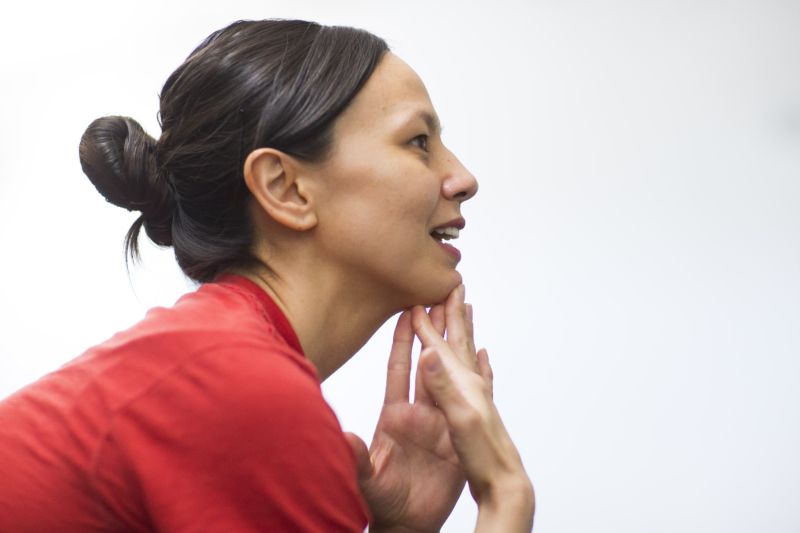GroundWorks is pleased to again collaborate with award-winning Chicago choreographer Robyn Mineko Williams whose creative residency will culminate in the world premiere of a new piece, debuting in July at Cain Park.
We recently sat down with Williams – previously a dancer for River North Dance as well as Hubbard Street Dance (both in Chicago) – for 12 seasons, to speak with her about her creative residency, where she finds inspiration and her experience working with GroundWorks.
On her second time choreographing work on the company, Williams noted, “The thing about GroundWorks that’s super attractive to dancers and dancemakers is how David Shimotakahara creates an environment where you’re free. It’s a true creative residency. It’s not about trying to bang out a product. I love it.”
Can you share a little about your dance background and what drew you to dance?
“I started dancing when I was five and haven’t stopped yet. I think I was drawn to dance because my mom used to dance when she was young. As a toddler, instead of actually sleeping when I was supposed to take naps, I would rummage around my mom’s closet and find all her leotards and point shoes to play dress up with. Me not wanting to take a nap was the first impulse that made me think, ‘I want to be like my mom — I want to dance.’
I began dancing with my mom’s old dance teacher at a suburban school. When I was nine years old, I saw Hubbard Street Dance Studio perform and fell in love — they were my dream company. Somehow, I was lucky enough to be able to study at their school and later dance with them professionally for 12 years.”
After leaving Hubbard Street in 2012, you transitioned into choreography. can you give insight as to what that was like?
“It was a leap that I didn’t even really know I was taking. Choreography was never in the plan. When I was deciding to leave Hubbard Street, it was clear to me that I needed to try something new. What I was going to try was unknown. I had interest in choreography and did create work while at Hubbard Street, but by no means ever saw myself as a choreographer.
When the time came for me to leave the company, I wasn’t ready to leave dance. Beginning to take choreographic jobs allowed me to stay immersed in dance in a new way. I just kept trying, practicing, learning and doing it. Enjoying this practice made me more interested in finding out what I could do and say within the line of choreography.”
You worked with GroundWorks DanceTheater before, what’s it like this time around for you?
“Everything is flowing. I came to Cleveland last week unsure about the piece I was going to make. I didn’t really even have a clear starting place. I just was going to show up and start.
As soon as I walked into the studio, there was an incredibly connected and genuine energy in the room. When I was introducing myself to the new dancers, I got to see how connected they are already and how strong their chemistry is. That’s the seed of the piece. Then, we got up and started to move. Things just started to come because they’re very open, which, in turn, makes me feel open and free to try new things.
With time being condensed, I was really nervous. The creative process for us is eleven rehearsal days and then we come back for tech. That’s not a lot of time to flesh out an idea, work on quality and get across what I’m trying to do with the dancers. But, it’s been such a happy and magical surprise that all of these things are happening without stress and extra effort.”
How would you explain your particular creative process?
“Each creation is different in the way it’s conceived and built. What it becomes depends on what ingredients are there. The dancers are what’s most important to me. As expressors, dancers are the ones that bring things to life. Dancers translate and interpret everything I’m trying to say. So, I rely a lot of them.
I have my own specific vocabulary so we can generate movement together, but there are always moments where I don’t know where to go next. I look to the dancers and ask, ‘What feels natural to you?’ or ‘How would you fall?’ or ‘How would you look at this person?’. A performance comes together by combining what I do and what the dancers do naturally, finding a world for that to live in and sculpting the relationships within the movements.
The creative process is a lot of making, editing, reshaping and adding. I’ve never sculpted before, but I’d imagine it’d be similar. You keep on chipping away and looking at the thing from a different perspective and then change an idea or go back to an idea. There’s a lot of trial and error to get to where we want to be. In the end, the hope is that you’ve formed a cohesive gem of an idea.”
What can you tell us about your creative residency looking ahead to your July performances?
“This particular piece is comprised as scenes that are happening along some sort of timeline. Whether that timeline is very short, happening in the evening or over a number of years is what we’re working on right now. We’re still figuring out the relationships between characters.
I feel like the piece is influenced by the mood of the music and that helps make sense of what is happening within interactions between the dancers. I love making something and allowing characters to pop out by being patient. It’s about letting those things happen naturally and recognizing it. Then, focusing in and fine-tuning it.”
How would you explain your style of choreography and influences?
“It’s really hard for me to define what I do. I was really lucky to have a lot of experiences and influences as a dancer. There are some experiences that I enjoyed and some I didn’t at all. This understanding allows me to pull from what I know and continue to learn from the artists I work with.
I feel like I’m a stew. Speaking stylistically with choreography and movement — I feel like I’m just a big stew of all of different people, ways, tools and more. I try not to think about what I do too much. I try to just do it, while being honest, having heart and just going for it and seeing what comes out.
I try not to forget what it was like to be a dancer in the studio. I learned a lot from the choreographer Jorma Elo. He made our job fun. He was fun and silly, but he got down to business.
That was a big lesson that I learned from him. That it’s dance. I feel like, personally, I function better when I’m having fun with the people around me and we can feel free to have fun while enjoying each other. It opens up your imagination and cool new things are able to happen that way.”

